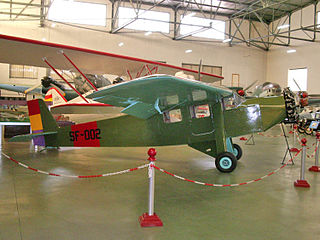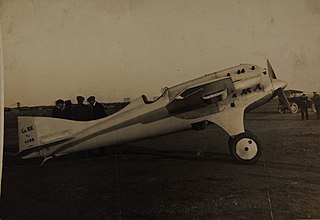Related Research Articles

The Farman F 400 was a 1930s French three-seat cabin high-winged monoplane which was designed and built by Farman.
The Farman F.480 Alizé was a single engine, two seat, parasol winged monoplane built in France in the mid-1930s. Designed as a tourer and trainer, all Alizés served as training aircraft for government (Republican) forces during the Spanish Civil War.
The Farman F.420 was a twin engine monoplane, built in France in the mid-1930s to compete in a government contest for an aircraft capable of fulfilling bomber, fighter and reconnaissance roles. Two prototypes were constructed but no production followed.
The Farman F.280 was a three engine, cantilever wing monoplane designed in France as a mail carrier in the early 1930s. Underpowered and slow, only two were built and briefly used.
The Farman F.30A C2 was a two-seat biplane designed as a fighter in France in 1916 and powered by a single, water-cooled radial engine. It showed poor flight characteristics and only one was built, though it was modified twice. It should not be confused with the similarly named Henry Farman HF.30 of 1915, a completely different aircraft which was used in large numbers by the Imperial Russian Air Service.
The Farman F.250 was a small, four passenger single engine low cantilever wing airliner built in France in 1931. The single example built was bought by an airline but was little used, owing to stability issues.

The Farman FF 65 Sport was a French built light biplane, with a single engine and tandem seats, intended for sport and touring. First flown in 1919, it achieved modest sales at home and abroad in the early 1920s. Two unusual modifications produced a biplane glider and a low aspect ratio parasol wing machine.

The Farman F.140 Super Goliath was a very large, four engine biplane night bomber, designed in France in the mid-1920s. Nine flew with the French Air Force until concerns about structural weakness grounded them in 1930. The prototype set several world records for altitude reached with heavy useful loads.
The Bernard SIMB V.1 was a French single seat racing monoplane designed to compete for the 1924 Beaumont Cup. It crashed on its first flight and was not rebuilt.

The Bernard SIMB V.2 was a single-seat, single-engine French monoplane, built in the mid-1920s. It was originally designed for racing but was adapted for a successful attempt on the world absolute speed record.
The Bernard SIMB AB 10 was a French single-engine, single-seat, highly streamlined, cantilever, all-metal low-wing monoplane of advanced design. It first flew in 1924 but was not ordered into production.
The Bernard H 110 was a single engine, single seat monoplane floatplane fighter designed for a French Navy competition. It flew in 1935 but had only made four test flights when the Bernard company was declared bankrupt, preventing further development.

The Bernard 200 T was the first of a series of French light touring aircraft from the early 1930s. Single engined and seating three or four, they were high cantilever wing monoplanes. Four Bernard 200 T were built and subsequently modified into three further variants.
The Bernard 260 C1 was a French all-metal, single-engine, low-wing monoplane with an open cockpit and fixed undercarriage, designed to a government single-seat fighter specification issued in 1930. After extensive comparative tests the Dewoitine D.500 was ordered in preference, though the performances of the two aircraft were similar.

The Loire-Nieuport 161 was a single-seat, single-engine, all-metal, low-wing monoplane fighter designed and built in France in 1935 to compete for a government contract. Accidents delayed its development and only three prototypes were completed.

The Wibault Wib 210 C.1 was a single engine, single seat low wing monoplane fighter aircraft, designed and built in France in the late 1920s. Flight tests revealed vibration problems and development was quickly abandoned.
The Wibault 313, Wibault Wib 313 or Penhoët Wibault Wib 313 was a single engine, single seat low wing monoplane fighter aircraft, designed and built in France in the early 1930s. It was entered into a government competitive tender programme but was not ordered.

The SFCA Lignel 10 was a French single seat aircraft designed to bridge a training gap between basic trainers and front-line fighters. The military requirement was soon dropped and only one was built.
The unsuccessful French Farman F.200 of 1923 shared its type name with the 1929 Farman F.200, the progenitor of a series of parasol wing tourers. It was a two-seat touring aircraft, with a low, thick, cantilever wing. Only one was built and only briefly tested.

The Dewoitine 14 was a mid-1920s French civil transport, capable of carrying mixture of passengers and freight. The sole example was used in commercial trials.